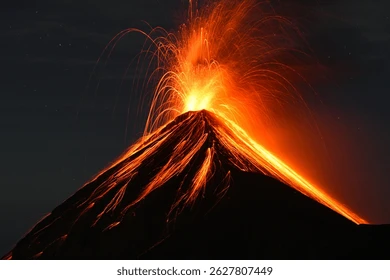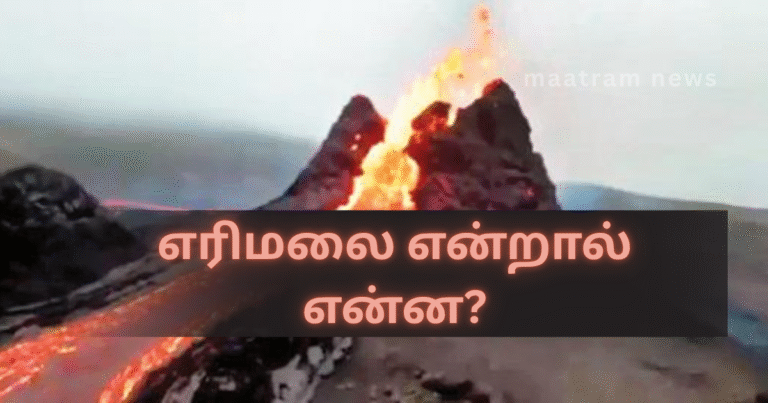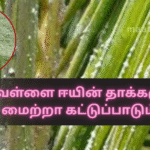எரிமலை (Volcano) என்பது பூமியின் அடியில் இருக்கும் உருகிய கற்கள், சூடான வாயுக்கள், லாவா, சாம்பல் ஆகியவை மிகுந்த அழுத்தத்தில் மேலே வெடித்து வெளிப்படும் ஒரு இயற்கை நிகழ்ச்சி.
பூமியின் மேற்பரப்பு பல பெரிய தட்டுகளால் (Tectonic plates) ஆனது. இந்த தட்டுகள் மோதும் போது, பிரியும் போது அல்லது கீழிறங்கும் போது மாக்மா (Magma) மேலே வந்து சேரும். இது சில நேரங்களில் நிலத்தடியில் சேர்ந்து அழுத்தம் அதிகரித்து வெடிப்பை ஏற்படுத்தும்.
அந்த வெடிப்பின் வழியாக லாவா, கற்கள், புகை, சாம்பல் ஆகியவை வெளிவருவதையே எரிமலை வெடிப்பு என்பார்கள்.
எரிமலைகள் பல காரணங்களால் முக்கியத்துவம் வாய்ந்தவையாக காணப்படுகின்றது.
- புதிய நில அமைப்புகள் உருவாகிறது
லாவா குளிர்ந்து கற்களாகி புதிய மலைகள், தீவுகள், தரை அமைப்புகள் உருவாகின்றன. (உதாரணம்: ஹவாய் தீவுகள்)
- வளமான மண் கிடைக்கிறது
எரிமலை சாம்பல் மற்றும் லாவா குளிர்ந்த பின் உருவாகும் மண் மிகப் பயனுள்ளதாக இருக்கும். இந்த மண் விவசாயத்திற்கு மிகச்சிறந்தது.
- கனிம வளங்கள் கிடைக்கின்றன
கனிமங்கள், தங்கம், வெள்ளி, செம்பு போன்றவற்றை எரிமலைகள் உருவாக்க உதவுகின்றன.
- சூடான நீரூற்றுகள் மற்றும் ஆற்றல்
Volcanoes-இல் இருந்து Geothermal Energy (நிலவெப்ப ஆற்றல்) உருவாகின்றது. பல நாடுகள் இதைப் பயன்படுத்தி மின்சாரம் தயாரிக்கின்றன.
🍁பூமியின் உள் அமைப்பு, புவியியல் மாற்றங்கள், நிலக்கீழ் வெப்ப சட்டங்களை விஞ்ஞானிகள் எரிமலைகள் மூலம் ஆய்வு செய்கின்றனர்.
🍁எரிமலை வெடிப்புகள் மனித உயிர், சொத்து, சுற்றுச்சூழலை பாதிக்கலாம். அதனால் முன்னெச்சரிக்கை முறைகள், கண்காணிப்பு தொழில்நுட்பங்கள் மிகவும் முக்கியம்.

எரிமலை உருவாகும் விதம் (How Volcanoes Form)
பூமியின் மேற்பரப்பு (Earth’s crust) என்பது ஒரே துண்டாக இல்லாமல், பல பெரிய மற்றும் சிறிய தட்டுகளாக (Tectonic Plates) பிரிந்துள்ளது. இந்த தட்டுகள் எப்போதும் மெதுவாக நகர்ந்து கொண்டிருக்கின்றன. இந்த நகர்வுகள் தான் எரிமலை உருவாக காரணமாகின்றன.
இரண்டு நிலத்தட்டுகள் ஒன்றுடன் ஒன்று மோதும் போது, ஒன்று மற்றதின் கீழ் செல்லும் (Subduction).
இதனால் அந்தத் தட்டின் கீழ் பகுதி உருகி மாக்மா ஆகிறது. இந்த மாக்மா அழுத்தத்தால் மேலே தள்ளப்பட்டு, இறுதியில் வெடித்து வெளிவந்தால் எரிமலை உருவாகிறது.
உதாரணம்: ஜப்பான்
இரண்டு தட்டுகள் ஒன்றை ஒன்று விட்டு விலகும் போது, கீழே உள்ள Mantle-இல் இருந்து மாக்மா மேலே எழுகின்றது. இந்த மாக்மா மேற்பரப்பில் வெளிவந்து புதிய நிலத்தை உருவாக்குகிறது.
இதுவும் ஒரு எரிமலை உருவாக்கும் செயலாகும்.
உதாரணம்: ஆப்பிரிக்கா – ரெட் சீ பகுதியில் உள்ள எரிமலை பகுதி
ஹாட்ஸ்பாட் (Hotspots) பகுதிகள்
சில இடங்களில் பூமியின் Mantle-இல் இருந்து மிகுந்த வெப்பம் நேரடியாக மேலே தள்ளும் பகுதிகள் உள்ளன. இவை “Hotspots” எனப்படும். இங்கு மாக்மா மேலே எழுந்து எரிமலை உருவாகும்.
உதாரணம்: ஹவாய் தீவுகள்
மாக்மா மேலே வருவது எப்படி?
பூமியின் உள்ளே மிகுந்த வெப்பம் உள்ளது. அந்த வெப்பத்தில் கற்கள் உருகி மாக்மாவாக மாறுகின்றன. மாக்மா லேசானது, அதனால் அது மேலே செல்லும். மேலே வந்த மாக்மா வெளிப்படாமல் உள்ளே அடைப்பில் சிக்கினால் அழுத்தம் உருவாகிறது. இந்த அதிக அழுத்தம் தாங்க முடியாதபோது வெடிப்பு ஏற்படும். இதையே Volcanic Eruption என்பார்கள்
வெடிப்பின் போது என்ன வெளிவரும்?
1.லாவா (உருகிய கல்)
2.சூடான வாயுக்கள்
3.சாம்பல்
4.கற்கள், தூள்
எரிமலைகள் எல்லாம் ஒரே மாதிரி இல்லை. லாவா வரும் விதம், அதன் வேகம், வெடிக்கும் சக்தி, அதன் வடிவம் ஆகியவற்றைப் பொறுத்து எரிமலைகள் பல வகைகளாக பிரிக்கப்படுகின்றன.
- Shield Volcano (கவச எரிமலை / அவன் போல மெதுவாக ஓடும் லாவா)
இவை மெல்லிய, நீண்ட வடிவத்தில் இருக்கும். லாவா மிகவும் அடர்த்தி குறைவானது (Thin Lava), அதனால் அது தண்ணீரைப் போல மெதுவாகவும் தொலைவு வரை ஓடவும் செய்கிறது.
குறிப்புகள்:
மிகப்பெரிய பரப்பளவு
வெடிப்பு மெதுவாகவும் குறைந்த அபாயத்துடனும்
அலையில்லா (non-explosive) eruption
உதாரணம்: ஹவாய் – மவுனா லோா (Mauna Loa)
- Stratovolcano / Composite Volcano (படிவ எரிமலை / மிகப்பெரிய வெடிப்பு எரிமலை)
இவை கூர்மையான சிகரத்துடன் கூடிய உயரமான மலை வடிவத்தில் இருக்கும்.
லாவாவும் சாம்பலும் மாறி மாறி சேர்ந்து இந்த எரிமலையை உருவாக்குகின்றன.
குறிப்புகள்:
மிக அதிக வெடிப்பு சக்தி
லாவா அடர்த்தி (தடித்த)
ஆபத்தான விழுந்து கிடக்கும் சாம்பல், கல் துண்டுகள்
உதாரணம்: மவுண்ட் ஃபூஜி (ஜப்பான்), மவுண்ட் வேசூவியஸ் (இத்தாலி)
- Cinder Cone (சிந்து-கோன் எரிமலை / கல் துண்டுகளால் உருவாகும்)
மிகச் சிறிய எரிமலை வகை இது. வெடிக்கும் போது வெளிவரும் கல் துண்டுகள், சாம்பல், சூடான துகள்கள் ஆகியவை ஒன்றன் மீது ஒன்று சேர்ந்து கூம்பு போல உயர்கின்றன.
குறிப்புகள்:
சிறிய அளவு
குறுகிய ஆயுட்காலம்
மிகக் குறைந்த வெடிப்பு சக்தி
சாம்பல் மற்றும் கல் துண்டுகள் அதிகம் வெளிவரும்
உதாரணம்: மெக்சிகோவில் உள்ள Parícutin
- Dormant Volcano (தற்காலிகமாக உறங்கும் எரிமலை)
இவை தற்போது வெடிக்காமல் இருந்தாலும் எதிர்காலத்தில் மீண்டும் வெடிக்கும் வாய்ப்பு உள்ளது.
குறிப்புகள்:
பல வருடங்கள் அமைதியாக இருக்கும்
விஞ்ஞானிகள் தொடர்ந்து கண்காணிக்க வேண்டியவை
உதாரணம்: ஜப்பான் – மவுண்ட் ஃபூஜி (சிலர் Dormant என வகைப்படுத்துகின்றனர்)
- Extinct Volcano (அணைந்த எரிமலை / இனி வெடிக்காத எரிமலை)
இவை இனி மீண்டும் வெடிக்கும் வாய்ப்பே இல்லை என்று விஞ்ஞானிகள் கருதுகின்றனர்.
குறிப்புகள்:
முடிவுற்ற எரிமலை செயல்பாடு
ஆயிரக்கணக்கான ஆண்டுகளாக செயல்பாடில்லாதது
உதாரணம்: ஸ்காட்லாந்தின் எரிமலை பகுதிகள்
எரிமலை வெடிப்புகள் உலகிற்கு இரண்டு விதமான விளைவுகளை ஏற்படுத்தும்: நன்மைகள் மற்றும் தீமைகள்.
நன்மைகள் (Benefits)
🌋புதிய நிலம் / மண் உருவாகும்
லாவா குளிர்ந்த பின் புதிய நிலப்பரப்புகள் உருவாகின்றன. இதனால் புதிய தீவுகள் மற்றும் மலைகள் உருவாகும் வாய்ப்பு ஏற்படுகிறது.
🌋கனிம வளங்கள் (Mineral Resources)
எரிமலை வெடிப்பால் உருவாகும் கற்கள் மற்றும் சாம்பல் வெவ்வேறு கனிம வளங்களாக மாற்றம் அடைகின்றன.
உதாரணமாக: தங்கம், வெள்ளி, செம்பு போன்றவை கிடைக்கும்.
🌋சூடான நீரூற்றுகள் / நிலவெப்ப ஆற்றல் (Geothermal Energy)
வெடிக்கும் இடங்களில் உள்ள வெப்பம், நீர் மூலம் மின்சாரம் தயாரிக்கப்படுகின்றது. இது புத்திசாலித்தன்மை வாய்ந்த இயற்கை ஆற்றல் ஆதாரம் ஆகும்.
தீமைகள் (Hazards)
🌋மனித இழப்புகள் (Human Losses)
மிகப்பெரிய எரிமலை வெடிப்புகள் உயிரிழப்புக்கு காரணமாகும். மக்கள் வசிப்பிடங்கள் அழியும்.
🌋லாவா மற்றும் சாம்பல் பரவல் (Lava and Ash Flow)
லாவா மற்றும் சாம்பல் பரவல் வீடுகள், பயிர்கள், சாலைகள் மற்றும் பிற கட்டிடங்களை சேதம் செய்யும்.
🌋விமானப் போக்குவரத்து பாதிப்பு (Air Travel Disruption)
சாம்பல் பறக்கும் போது விமானங்கள் பாதிக்கப்படுகின்றன. பறக்கும் பாதை ரத்து செய்யப்படலாம்.
🌋சுற்றுச்சூழல் மாற்றங்கள் (Environmental Changes)
மண், நீர், காற்று மாற்றங்கள் ஏற்படும். சுற்றுச்சூழல் மீளாத பாதிப்புகளை எதிர்கொள்ள நேரிடலாம்.
🌋உலகின் முக்கிய எரிமலைகள்
எரிமலைகள் உலகம் முழுவதும் காணப்படுகின்றன. சில முக்கியமானவை அறிவியல், சுற்றுலா மற்றும் வரலாற்று நோக்கங்களுக்காக பிரபலமானவை.

- மவுண்ட் வேசூவியஸ் (Mount Vesuvius) – இத்தாலி
இத்தாலியில் உள்ள இந்த எரிமலை பழங்கால வரலாற்றிலும் பிரபலமாக உள்ளது. குறிப்பாக, 79 ஆம் ஆண்டில் பம்பெயி நகரத்தை அழித்த வெடிப்பால் இது உலகிற்கு அறியப்பட்டது.
- மவுண்ட் ஃபூஜி (Mount Fuji) – ஜப்பான்
ஜப்பானின் உயரமான எரிமலை, அழகான கூர்மையுடன் உள்ள மலை வடிவம் கொண்டது. இது இன்னும் dormant volcano ஆகும், எதிர்காலத்தில் வெடிக்க வாய்ப்பு உள்ளது. சமீபத்தில் சிறிய அச்சுறுத்தல்கள் (minor eruptions) பதிவாகியுள்ளன.
- கிலாவேயா (Kīlauea) – ஹவாய்
ஹவாயியில் உள்ள இந்த எரிமலை மிகவும் செயல்பாட்டில் உள்ளது. லாவா மிகவும் மென்மையாக ஓடுவதால் நிலப்பரப்பை விரிவாக்கும். ஹவாயி தீவுகள் பெரும்பாலும் இதன் செயல்பாட்டால் உருவானவை.
- இந்தியா – பேரிகன் ஹில்ஸ் (Barren Island, Andaman)
இந்தியா一கான செயலில் இருக்கும் எரிமலை பேரிகன் தீவு. இது அரபிக் கடலின் வடகிழக்குப் பகுதியில் Andaman தீவுகளில் உள்ளது.
இன்னும் செயல்பாட்டில் உள்ளது
இந்தியாவிற்கு முக்கியமான எரிமலைகளில் ஒன்றாக கருதப்படுகிறது.
- அதிகாரிகள் வழங்கும் அறிவுறுத்தல்களை பின்பற்றுதல்
அரசாங்கம், அச்சுறுத்தல் நிலையங்கள் மற்றும் பணியாளர்களால் வழங்கப்படும் அறிவுறுத்தல்களை கவனமாக பின்பற்ற வேண்டும்.
கட்டிடங்களை விட்டு செல்ல வேண்டிய சூழல் ஏற்படும் போது உடனடியாக புறப்பட வேண்டும்
பாதிக்கப்பட்ட இடங்களில் நுழைய வேண்டாம்
- N95 முகக்கவசம் அணிதல்
எரிமலை வெடிக்கும் போது வெளிவரும் சாம்பல், தூள், வாயுக்களை முகம் மூடாமல் சுவாசித்தால் சுவாச பாதிப்புகள் ஏற்படும்.
N95 வகை முகக்கவசம் அணிந்து சுவாசத்தை பாதுகாக்கலாம்
குழந்தைகள் மற்றும் முதியோர் இதை தவறாமல் பயன்படுத்த வேண்டும்
- தங்கும் முகாம் / பாதுகாப்பு நிலையங்கள் (Shelters)
முகாம்கள் அல்லது பாதுகாப்பு நிலையங்கள் வெடிப்பு நேரத்தில் பாதுகாப்பான இடமாக இருக்கும்.
புறப்படும் முன் முகாம்கள் எங்கு உள்ளன என்று தெரிந்துகொள்ள வேண்டும்
குடும்பத்தோடு சேர்ந்து பாதுகாப்பான இடத்தில் தங்க வேண்டும்
- அவசியப் பொருட்களை வைத்திருத்தல் (Essentials: Food, Water, etc.)
நீர், உணவு, முதல் சிகிச்சை பெட்டி, பேடரி மின் விளக்கு போன்ற முக்கிய பொருட்களை முன்னதாக தயாரித்து வைத்திருத்தல் அவசியம்.
குறைந்தபட்சம் 72 மணி நேரம் காத்திருக்கக்கூடிய அளவு
குழந்தைகள், முதியோர் மற்றும் நாய்கள்/பூனை போன்ற செல்லப்பிராணிகள் க்கு தேவையானது
⚡எரிமலை என்பது இயற்கையின் மிகப்பெரிய அதிசயம். இது பூமியின் உருவாக்கத்தில் முக்கிய பங்கு வகிக்கின்றது, புதிய நிலம், மண், கனிம வளங்கள் மற்றும் சூடான நீரூற்றுகள் போன்ற நன்மைகளை தருகிறது.
⚡ஆனால், அதே சமயம் எரிமலை வெடிப்புகள் மனித உயிர், சொத்து மற்றும் சுற்றுச்சூழலைப் பாதிக்கும் அபாயத்தையும் கொண்டுள்ளது. இதனால், எரிமலை உள்ள பகுதிகளில் வசிக்கும் மக்கள் அதிகாரிகள் வழங்கும் அறிவுறுத்தல்களை பின்பற்றுதல், பாதுகாப்பு முகாம் மற்றும் அவசியப் பொருட்களை முன்னதாக தயார் செய்வது போன்ற முன்னெச்சரிக்கை நடவடிக்கைகள் அவசியம்.
⚡எரிமலைகளை அறிந்து, பாதுகாப்பாக வாழ்வதன் மூலம், இயற்கையின் அதிசயங்களையும், மனித வாழ்க்கையின் பாதுகாப்பையும் இணைந்து பாதுகாக்க முடியும்.
மேலதிக தகவல்களுக்கு மாற்றம் செய்திகள் இணையத்தளத்தினுள் பிரவேசியுங்கள்.
மேலதிக தகவல்களை உடனுக்குடன் பெற்றுக்கொள்ள மாற்றம் செய்திகள் முகநூல் பக்கத்தை பின்தொடரவும்.
What is a Volcano?
A volcano is a natural phenomenon where molten rocks, hot gases, lava, and ash from beneath the Earth erupt to the surface under intense pressure.
The Earth’s crust consists of several large tectonic plates. When these plates collide, separate, or subduct, magma from below rises to the surface. Sometimes, as it accumulates underground, pressure builds up and causes an eruption. The eruption releases lava, rocks, gases, and ash—this is called a volcanic eruption.
Volcanoes are significant for several reasons:
- Formation of new land: Lava solidifies into rocks, forming new mountains, islands, and land surfaces. (Example: Hawaiian Islands)
- Fertile soil: The cooled lava and ash create fertile soil, which is highly suitable for agriculture.
- Mineral resources: Volcanoes contribute to the formation of minerals such as gold, silver, and copper.
- Geothermal energy: Volcanoes produce heat that can be harnessed for geothermal energy. Many countries use this heat to generate electricity.
🌿 Scientists study volcanoes to understand the Earth’s internal structure, geological changes, and subterranean heat patterns.
🌿 Volcanic eruptions can threaten human life, property, and the environment. Therefore, early warning systems and monitoring technologies are crucial.
How Volcanoes Form
The Earth’s crust is not a single solid piece but is divided into several large and small tectonic plates. These plates are constantly moving slowly. These movements are the main cause of volcano formation.
- Convergent Boundaries (Colliding plates):
When two tectonic plates collide, one plate may subduct beneath the other. The subducted plate melts, forming magma. Under pressure, this magma rises and eventually erupts as a volcano.
Example: Japan - Divergent Boundaries (Separating plates):
When two plates move apart, magma from the mantle rises through the gap, creating new land. This process also forms volcanoes.
Example: Red Sea region, Africa - Hotspots:
In some regions, magma rises directly from the Earth’s mantle due to concentrated heat. These are called hotspots. Magma rises here and forms volcanoes.
Example: Hawaiian Islands
How magma rises:
The Earth’s interior is extremely hot, melting rocks into magma. Because magma is less dense, it rises. If it gets trapped underground, pressure builds up, and when it exceeds the containment, it erupts—this is a volcanic eruption.
What is released during an eruption:
- Lava (molten rock)
- Hot gases
- Ash
- Rocks and dust
Types of Volcanoes
Volcanoes vary in shape, eruption style, and lava characteristics:
- Shield Volcano (Gentle, flowing lava):
- Broad, gentle slopes
- Slow, non-explosive eruptions
- Thin lava that flows long distances
Example: Mauna Loa, Hawaii
- Stratovolcano / Composite Volcano (Steep, explosive):
- Tall, steep-sided mountains
- Alternate layers of lava and ash
- Highly explosive eruptions
Example: Mount Fuji, Japan; Mount Vesuvius, Italy
- Cinder Cone Volcano:
- Small volcanoes
- Short lifespan
- Eject ash, rocks, and small fragments that form a cone
Example: Parícutin, Mexico
- Dormant Volcano:
- Currently inactive but may erupt in the future
- Requires continuous scientific monitoring
Example: Mount Fuji, Japan (classified as dormant by some)
- Extinct Volcano:
- No longer capable of erupting
- Inactive for thousands of years
Example: Some volcanoes in Scotland
Effects of Volcanic Eruptions
Volcanic eruptions have both benefits and hazards:
Benefits
🌋 New land / soil formation:
Cooled lava creates new land surfaces, forming islands and mountains.
🌋 Mineral resources:
Erupted rocks and ash contain valuable minerals like gold, silver, and copper.
🌋 Geothermal energy:
The heat generated during eruptions can be harnessed to produce electricity.
Hazards
🌋 Human losses:
Major eruptions can cause fatalities and destroy settlements.
🌋 Lava and ash flow:
Can damage homes, crops, roads, and infrastructure.
🌋 Air travel disruption:
Flying ash clouds can disrupt aviation routes and cause flight cancellations.
🌋 Environmental changes:
Alterations in soil, water, and air quality can cause lasting environmental impacts.
Famous Volcanoes in the World
Volcanoes are found worldwide. Some of the most famous include:
- Mount Vesuvius, Italy: Known historically for the 79 AD eruption that destroyed Pompeii.
- Mount Fuji, Japan: Japan’s tallest volcano, currently dormant but still monitored.
- Kīlauea, Hawaii: Highly active, with slow-flowing lava expanding land on the islands.
- Barren Island, Andaman, India: India’s only active volcano, located in the Andaman Islands; still active and scientifically significant.
Safety Tips During Volcanic Eruptions
- Follow official instructions:
Obey government and disaster authorities. Evacuate immediately if instructed and avoid affected areas. - Wear N95 masks:
Protects against inhaling ash, dust, and harmful gases. Especially important for children and the elderly. - Shelters / safe locations:
Identify safe shelters before an eruption. Stay with family in protected areas. - Keep essential supplies:
Store water, food, first aid kits, battery-powered lights, and other necessities for at least 72 hours. Include items for children, elderly, and pets.
Conclusion
⚡ Volcanoes are one of nature’s greatest wonders. They play a key role in shaping the Earth, forming new land, fertile soil, mineral resources, and geothermal energy.
⚡ At the same time, volcanic eruptions can threaten human life, property, and the environment. Residents of volcanic regions must follow official guidance, prepare shelters, and stock essential supplies.
⚡ By understanding volcanoes and taking safety precautions, we can appreciate nature’s wonders while protecting human life.


